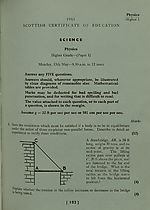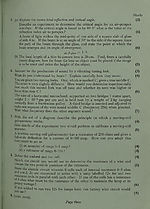Download files
Complete book:
Individual page:
Thumbnail gallery: Grid view | List view

Marks
2. State Newton’s Second Law1 of Motion and show' how' the unit of force in the
f p s system is derived from it. (5)
Describe the experiment you would do to show how' the acceleration produced
in a body is related to the applied force. (7)
A motor car weighing one ton is accelerated from rest to 30 mph in 5 seconds;
assuming the power of the engine to be uniform and neglecting frictional losses
calculate (i) the required horsepower of the engine; (ii) the maximum slope up
which this motor car could maintain a steady speed of 30 mph. (8)
3.
Define pressure at a point in a fluid. Show how the Principle of Archimedes
may be deduced from consideration of pressure in a fluid.
Why does the pressure in the atmosphere not depend on height in a simple
way ?
Given a solid cube of brass and a cylinder of the same brass suspected of
containing a small cavity, how would you determine the volume of the cavity,
if any ?
A polythene bag is sealed w'hen it contains 1 litre of air at atmospheric pressure,
and is placed under water at the same temperature as the air. Assume that the
dimensions of the bag are negligible compared with the depth considered. If
the bag is 1700 cm below' the surface of the water would it resurface or not if
attached to a lead alloy sinker of mass 420 gm ? State tw'O of the difficulties
ignored in making the assumption stated above.
Weight of polythene bag
Atmospheric pressure
Density of lead alloy
Density of mercury
Density of air
= 1 gm.
= 75 cm of mercury.
= 10 gm per cc.
= 13-6 gm per cc.
= 1-25 gm per litre at atmospheric pressure and
at temperature of the experiment.
(7)
(5)
(8)
Define specific heat and mechanical equivalent of heat.
In finding the specific heat of iron by the method of mixtures, what are the two
major. sources of error ? How do you minimise these errors ? Discuss the
effect each would have on the value of the specific heat determined by the
experiment if no precautions were taken.
If in finding the latent heat of steam by passing steam into water, the steam was
not dry, state with reasons the effect this would have on the final result.
If a 1 kilowatt electric kettle containing 1 litre of water at 20°C has electrical
energy supplied for 10 minutes how much water will be boiled aw'ay assuming
a 10 per cent loss of heat ?
J =4-2 joules per cal
L = 540 cal per gm
(4)
(7)
(3)
(6)
Page tzvo
2. State Newton’s Second Law1 of Motion and show' how' the unit of force in the
f p s system is derived from it. (5)
Describe the experiment you would do to show how' the acceleration produced
in a body is related to the applied force. (7)
A motor car weighing one ton is accelerated from rest to 30 mph in 5 seconds;
assuming the power of the engine to be uniform and neglecting frictional losses
calculate (i) the required horsepower of the engine; (ii) the maximum slope up
which this motor car could maintain a steady speed of 30 mph. (8)
3.
Define pressure at a point in a fluid. Show how the Principle of Archimedes
may be deduced from consideration of pressure in a fluid.
Why does the pressure in the atmosphere not depend on height in a simple
way ?
Given a solid cube of brass and a cylinder of the same brass suspected of
containing a small cavity, how would you determine the volume of the cavity,
if any ?
A polythene bag is sealed w'hen it contains 1 litre of air at atmospheric pressure,
and is placed under water at the same temperature as the air. Assume that the
dimensions of the bag are negligible compared with the depth considered. If
the bag is 1700 cm below' the surface of the water would it resurface or not if
attached to a lead alloy sinker of mass 420 gm ? State tw'O of the difficulties
ignored in making the assumption stated above.
Weight of polythene bag
Atmospheric pressure
Density of lead alloy
Density of mercury
Density of air
= 1 gm.
= 75 cm of mercury.
= 10 gm per cc.
= 13-6 gm per cc.
= 1-25 gm per litre at atmospheric pressure and
at temperature of the experiment.
(7)
(5)
(8)
Define specific heat and mechanical equivalent of heat.
In finding the specific heat of iron by the method of mixtures, what are the two
major. sources of error ? How do you minimise these errors ? Discuss the
effect each would have on the value of the specific heat determined by the
experiment if no precautions were taken.
If in finding the latent heat of steam by passing steam into water, the steam was
not dry, state with reasons the effect this would have on the final result.
If a 1 kilowatt electric kettle containing 1 litre of water at 20°C has electrical
energy supplied for 10 minutes how much water will be boiled aw'ay assuming
a 10 per cent loss of heat ?
J =4-2 joules per cal
L = 540 cal per gm
(4)
(7)
(3)
(6)
Page tzvo
Set display mode to:
![]() Universal Viewer |
Universal Viewer | ![]() Mirador |
Large image | Transcription
Mirador |
Large image | Transcription
Images and transcriptions on this page, including medium image downloads, may be used under the Creative Commons Attribution 4.0 International Licence unless otherwise stated. ![]()
| Scottish school exams and circulars > Scottish Certificate of Education > 1963 > (396) |
|---|
| Permanent URL | https://digital.nls.uk/130803884 |
|---|
| Attribution and copyright: |
|
|---|---|
| Shelfmark | GEB.16 |
|---|---|
| Additional NLS resources: | |
| Description | Examination papers for the School Leaving Certificate 1888-1961 and the Scottish Certificate of Education 1962-1963. Produced by the Scotch (later 'Scottish') Education Department, these exam papers show how education developed in Scotland over this period, with a growing choice of subjects. Comparing them with current exam papers, there are obvious differences in the content and standards of the questions, and also in the layout and use of language |
|---|---|
| Additional NLS resources: |
|



